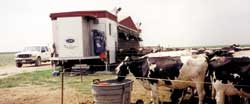
In an attempt to produce milk more economically, Mark McAfee has put together a portable 20-cow milking parlor that he moves from pasture to pasture. His 350-cow herd is on a rotational grazing program.
McAfee, Kerman, California, is the managing partner of Organic Pastures Dairy Co., LLC, an organic Grade A dairy that sells milk through Organic Valley Cooperative.
McAfee designed the parlor himself, and hired contractors to put together the trailer it's built on and the building itself. Design was important. It needed to be portable enough that he could move it with a tractor and self-contained so he could milk with automatic milkers and meet all the standards for Grade A milk.
The moveable parlor sits on a specially built Eaton axle with 16 wheels. It's 65 ft. long, 12 ft. wide and 12 ft. high. Cattle are milked in a "cage," which is basically a herringbone layout on a platform. When the cows enter, the platform is at ground level. Once the stalls are filled, hydraulic cylinders raise it up 4 1/2 ft., so for workers at ground level, it's like being in a pit.
McAfee worked closely on the design with Schleuter, the company that supplied milking equipment for the portable parlor. It has rubber floors and several 1-in. thick rubber 4 by 4-ft. mats laid out on the ground in front of the doors so the cattle don't create a muddy area walking in and out.
"We have everything you'd have in a conventional parlor, including milk-sensing automatic take-offs," he tells. "Our cows are always on pasture, where they'd prefer to be. We don't use barns and they never set foot on concrete."
To provide electricity for the portable parlor, McAfee installed a generator powered by a John Deere 140 hp turbocharged diesel engine. The electrical system is 480 volts, although they step it down for some uses. The parlor's hydraulic system is powered by a 40 hp. electric hydraulic pump. It also has an electric water heater, although some of the heat is reclaimed from the engine's exhaust.
In his rotational grazing system, McAfee moves his herd about once a week. He pulls the 57,000-lb. parlor from pasture to pasture with a Case-IH 7220 150 hp front wheel assist tractor. Once he has it in place, it's leveled by hydraulic cylinders at the corners.
Because it is a Grade A system, milk must be stored in a central location. At the parlor, milk is quickly cooled and then pumped into a portable insulated 1,300-gal. tank designed just for this purpose. It's mounted on a special trailer with a hitch on both ends, so they don't have to back it up or turn it around. After milking is over, the tank is pulled to a centralized 6,000-gal. bulk storage silo, where it's picked up by the milk transport truck.
McAfee says the parlor cost a little more than most milking parlors of similar size. With his system, though, he has hardly any other building and facility costs. With the cattle always on pasture, he needs no manure holding or handling equipment. There are no lots, no pens, no freestalls, no need for bedding, and not much need for feed storage, either. He does have a portable bunk from which he feeds a grain and protein supplement, but cattle get most of their forage needs from pasture.
McAfee's rotational grazing system has resulted in very good cow health and an almost unbelievable average standard plate cell count of 1,100. (For the record, pasteurized milk is allowed a plate count of 3,000).
"We hardly ever have to treat a cow for anything. And our cull rate for all reasons is just 12 percent," he says. "Cattle would never be this healthy in barns or concentrated in lots."
With such a low bacteria count, McAfee is well below the level allowed for raw milk sales. He says there's an established and growing market for organic raw milk, and he'll begin packaging some of his milk for raw milk customers later this year.
